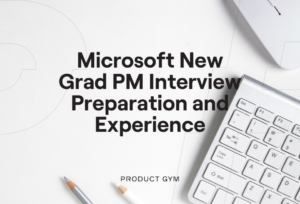Any business, no matter how small, has to manage a lot of moving parts and competing priorities. Add in multiple stakeholders, shifting deadlines, and growing lists of customers, and you’ve got a real challenge on your hands. That’s why organizations turn to companies like Asana, a project and work management tool designed to keep everyone on track and aligned with regard to goals. It’s a solution that many product teams use to manage cross-functional projects and workflows. And because PMs are often familiar with these kinds of tools, working for one seems like a natural choice. If Asana sounds like the company for you, read on to learn how to ace interview and become an Asana Product Manager.
Company Overview
Asana is a project management software solution that helps teams manage workflows, tasks, and shared responsibilities. Their software can be used by any industry and for any kind of work, from daily or weekly tasks to company-wide initiatives. Some of the most well-known companies in the world, including Amazon, Deloitte, Google, Slack, Uber, and Zappos, use Asana to manage everything from marketing campaigns and event plans to product launches and quarterly objectives.
In fact, Asana started at another big-name company: Facebook. Co-founders Dustin Moskovitz and Justin Rosenstein worked together at the social media giant. In fact, Moskovitz, who had been one of Mark Zuckerberg’s college roommates, was Rosenstein’s boss. As Facebook scaled, Rosenstein noticed that more and more time was being taken up by meetings, distracting the team from the real work and ideation that would drive the company forward. To help, Rosenstein and Moskovitz created a “Tasks” application, which proved extremely useful.
While working together, Moskovitz and Rosenstein learned that they were both active yoga and meditation practitioners and shared an admiration for Buddhism and Taoism. In 2008, the two left Facebook to found Asana, using the Tasks tool as the foundation for the business. Before building out the product more fully, however, they set the company’s core values. Both believed that culture would be the key to their continued success in such a crowded market.
The name Asana was inspired by Moskovitz and Rosenstein’s passion for yoga. “Asana” is a Sanskrit word for the pose/position assumed by the yogi. The founders thought it reflected what they hoped Asana’s software would do, namely bring about focus and flow for busy teams.
In April of 2012, they released the first commercial version of Asana. Just a few months later, the company secured a $28M Series B investment. More funding rounds followed as the organization scaled rapidly. By late 2018, Asana had a customer base of over 50,000 paying accounts. Among them were multinational enterprises like IBM, eBay, and Uber. The company went public (NYSE: ASAN) via a direct public offering in September of 2020.
Today, Asana is headquartered in San Francisco, with satellite offices in New York City, Tokyo, London, Dublin, Reykjavik, Sydney, Singapore, and Munich. The company is headed by CEO and co-founder Dustin Moskovitz, and employs over 900 people. More than 100,000 companies are paying Asana customers, and they have millions of free users across the globe.
Product Culture at Asana
Asana distributes its productivity solution via a software-as-a-service (SaaS) model, and paid versions are billed per user, per month. The company has four product tiers: Enterprise, Business, Premium, and Basic. The Basic tier is a “forever free” option that offers unlimited essential functionality plus a few extras for teams of up to 15. Premium subscribers receive additional features such as automated workflows and expanded reporting options. The Business tier offers advanced reporting and workflow functionality, and the Enterprise tier has all of the “bells and whistles” required by large, multinational organizations.
In addition, Asana has both Android and iOS mobile applications, an API, and a thought leadership site called Wavelength.
Overall Company Culture
Asana’s company leadership considers its culture to be one of its differentiators, both as a workplace and as a product. At the center of it are their nine core values, which existed even before the software did. The first value is “Mission:” basically, to keep the company’s overall mission (“to help humanity thrive by enabling the world’s teams to work together effortlessly”) at the core of everything the team does. The other eight are:
- Do great things, fast
- Clarity
- Co-creation
- Give and take responsibility
- Mindfulness
- Reject false tradeoffs
- Be real (with yourself and others)
- Heartitude
Product Team Culture
At Asana, the product team is extremely customer-focused and collaborative, working with multiple stakeholders and across departments to make the user experience as intuitive and seamless as possible. The product team itself encompasses multiple product-related functions, including product management, product design, brand design, and UX research. The team is also highly focused on professional growth and mentorship, offering free executive coaching sessions and clear success guides.
What Does a Typical Asana PM Job Posting Look Like?
Each Asana product management job description begins with an overview of what the product team does at the company and what specific product area the PM would be responsible for. It also includes some of the core initiatives the person would be working on and mentions which teams they’d be collaborating with most closely.
Next comes a “what you’ll achieve” section, which lists expected results for the individual in the role. These vary by position. For example, the Product Manager, Consistency & Control position shown below lists “Be a key leader in driving the adoption of Asana at enterprise-level customers” as one desired achievement.
Up next is an “about you” section, which is essentially a list of qualifications. Most PMs at Asana have 4+ years of experience, and should possess the following:
- Excellent communication skills, both written and oral
- A “get stuff done” attitude
- A passion for teaching and mentorship
- Experience building and executing on a product strategy
- Strong collaboration skills
- A “growth mindset: leads with curiosity, open to feedback”
The final piece is an “About us” section, which describes the benefits of working for Asana. These include professional development programs, generous parental leave, flexible hours, free meals, and more.
How Do You Get an Asana Product Manager Interview?
Get started by browsing Asana’s current job openings to find the position(s) most suited to your specific skills, experience, areas of expertise, and career goals. Once you’ve picked out one (or more) that look like good fits, your next step is to create a well-thought-out application. Up first is your resume.
Craft a Strong PM Resume
The hiring manager at Asana will most likely look at your resume first. Be sure to show off your skills and relevant job experience, as well as highlight any past experience involving the specific responsibilities and tasks listed in the job description. If you can point to previous quantitative results around those aspects of the role, definitely do so.
Before updating your resume, check out our free webinar on resume writing, which takes you through the process of building a well-organized resume that you can use for multiple PM positions.
Create Your Pitch and Position Yourself as a Top-Tier PM Hire
Your next step is to highlight your product management skills. You can do that by writing a pitch that showcases the product manager position’s key responsibilities. Here’s how.
Apply!
The last step is to submit your application. But don’t stop there — if you know any Asana employees, reach out to request a referral. According to Glassdoor, 15% of interviewees got their foot in the door through an employee referral. Our step-by-step recruiter networking methodology can also help you secure that critical first interview.
What Is the Interview Process and Timeline?
The PM hiring process at Asana generally follows these steps:
- Take-home assignment + introductory call with product team member
- Presentation + technical and behavioral round(s) with team members and stakeholders
- The offer
Typically, the process takes about one to four weeks from start to finish. According to Glassdoor, 50% of interviewees had a positive experience, and the average interview difficulty was rated a 3.1 out of 5.
How to Win the Take-Home Assignment + Introductory Call With a Product Team Member
Unlike most companies, Asana starts its hiring process off with a take-home assignment. During the initial recruiter call, candidates receive an assignment to complete before their first interview. The assignment should take a few hours and the goal is to see how you’d think through a problem and come to a potential solution. According to a few Glassdoor responses, the assignment prompt is “Pretend you are the PM of Stitcher. What feature would you build to test the assumption that users who interact with other users have a better experience?”
During the interview with the PM team member, you’ll be given feedback on the assignment and asked some questions about your reasoning. You should also be prepared to answer the following questions:
- Tell us about your current role.
- Tell me about yourself.
- What’s your favorite product? Why? What would you improve about it?
- Come up with a new feature for your favorite product and tell us how you’d measure its success.
- If you were the PM for X app and you had to improve Y, how would you approach it?
- Suppose you are the PM for (insert company) and you assume X. What feature would you build to test this hypothesis and why?
- What metrics would you look at for X product?
- X metric is down Y%. What do you do?
If you do well during this round, you’ll be asked to interview with additional members of the product team, along with design and engineering leads.
How to Win the Technical and Behavioral Round(s) With Team Members and Stakeholders
Some Glassdoor responses mentioned having to create a Powerpoint presentation around your experience/background prior to this round, so that’s a possibility to prepare for. Generally, this stage will include targeted questions around product, design, and analytics, as well as a few in-depth behavioral questions. Be ready to answer the following:
- Design a fridge for kids.
- How would you design an Uber for laundry?
- You work at a refrigeration company. How would you expand into the business market?
- You just joined an e-commerce company and the developer team built a Product Recommendation section. Would you launch the feature? If so, how would you measure success?
- Tell me how you’d go about defining requirements and building a product that’s a YouTube competitor.
- How might you reinvent the office fridge?
After this round, the hiring decision is in the team’s hands. Good luck!
How Did COVID-19 Change Hiring at Asana?
Like most organizations, Asana shifted to a fully-remote interviewing process during the COVID-19 pandemic. They even offered candidates the chance to do a video call with a recruiter prior to their interview to help them get over their remote interviewing nerves (FYI, we can help you do that, too, with our guide to virtual interviews). In spite of the pandemic, Asana hired more than 500 employees in 2020.
Before the COVID-19 crisis, very few Asana employees worked remotely. However, the company plans to be accommodating when it comes to worker preferences and needs, allowing for flexibility with regard to location. Rather than set fixed dates for a return-to-office, they will be asking each employee which environment would make them most productive. However, the overall company culture will remain focused on the office. Open job descriptions state, “We are safely and mindfully returning our global teams to in-person collaboration, incorporating flexibility that adds hybrid elements to our office-centric culture.” Currently, Asana has nearly 200 open positions, including several product management roles.
Want to learn more about winning the Asana Product Manager interview or about getting hired at a top-tier company? Our career coaches are currently offering free sessions: schedule yours today. We’d be glad to answer any questions you may still have.
Next, you can check out these blogs to win the product manager interview:



